Abstract
In the present article, we classify conformally flat weakly Ricci-symmetric space-times and obtain that they represent Robertson–Walker space-times. Furthermore, we provethat a Ricci-recurrent weakly Ricci-symmetric space-time is static and a Ricci-semi-symmetric weakly Ricci-symmetric space-time does not exist. Further, we acquire the conditions under which a weakly Ricci-symmetric twisted space-time becomes a generalized Robertson–Walker space-time. Also, we examine the effect of conformally flat weakly Ricci-symmetric space-time solutions in gravity by considering two models, and we see that the null, weak and strong energy conditions are verified, but the dominant energy condition fails, which is also consistent with present observational studies that reveal the universe is expanding. Finally, we apply the flat Friedmann–Robertson–Walker metric to deduce a relation between deceleration, jerk and snap parameters.
Keywords:
Robertson–Walker space-time; weakly Ricci-symmetric space-time; energy conditions; f (R,G) gravity MSC:
53Z05; 83C05; 83C10; 83C40
1. Introduction
From the theory of general relativity, we know that a space-time is a Lorentzian manifold having the signature and that it allows a globally time-oriented vector. Perfect fluids perform a fascinating role in general relativity, being the root of Einstein’s field equations. Recently, physicists have used perfect fluid models to investigate plasma physics, nuclear physics and astrophysics. Many geometers have examined space-times using a variety of methodologies, such as in [,,] and many others.
is called a generalized Robertson–Walker space-time [] if it can be expressed by , in which indicates an open subset of and indicates an -dimensional Riemannian manifold. Specifically, a generalized Robertson–Walker space-time represents Robertson–Walker space-time if is of dimension three and of constant curvature.
Among other limitations, Robertson–Walker space-times and generalized Robertson–Walker space-times are characterized by the presence of a torse-forming unit and a time-like vector []. They illustrate that the presence of a single, unique vector may still define twisted manifolds without any additional constraints. Twisted manifolds generalize Robertson–Walker and generalized Robertson–Walker space-times because they include a scale function that depends on both space and time.
This leads to the definition of twisted space-times. Twisted space-times are significantly more general than warped space-times, which involve periodic alterations to the world. Twisted space-times were initially conceptualized by Chen [], who defined them as a Lorentzian manifold with the metric (in local form)
where indicates the metric tensor of an (n-1)-dimensional Riemannian manifold. If is only a function of t, then the twisted space-time becomes a generalized Robertson–Walker space-time. For further details about generalized Robertson–Walker, Robertson–Walker, and other space-times, see [,,,,,,,,,].
If is a perfect fluid space-time, then the non-zero Ricci tensor fulfills
in which a and b stand for scalars and u denotes the unit time-like vector, that is, . u is also known as the velocity vector or flow vector.
For a perfect fluid space-time [], the energy momentum tensor is demonstrated by
where p and indicate isotropic pressure and energy density. Also, the state equation relates and p. Here, the perfect fluid space-time is called isentropic. Also, for , the space-time reveals stiff matter []. According to the Einstein field equations without a cosmological constant,
where is the gravitational constant and R is the Ricci scalar. The Equations (3) and (4) together yield the Equation (2) [].
Sen and Chaki [] investigated certain curvature constraints on a particular type of class one conformally flat spaces in 1967, and derived the covariant derivative of the Ricci tensor as follows:
where is the covariant vector and ∇ indicates the covariant derivative.
In 1988, Chaki [] defined a non-flat Riemannian manifold as a pseudo-Ricci-symmetric manifold where the Ricci tensor satisfies (5). Generalizing this notion, Tamássy and Binh [], in 1993, developed the concept of n-dimensional weakly Ricci-symmetric manifolds. If an n (≥3)-dimensional Riemannian or semi-Riemannian manifold has a non-zero , and the following condition is satisfied:
where , and are the covariant vectors (not simultaneously zero) and ∇ is the covariant derivative, then the manifold is said to be weakly Ricci-symmetric. If , then this manifold turns into a Ricci-symmetric manifold []. According to Chaki and Koley, the manifold is referred to as a generalized pseudo-Ricci-symmetric manifold [] if the vector in (6) is replaced with . Hence, the defining condition of a weakly Ricci-symmetric manifold is a little weaker than that of a generalized pseudo-Ricci-symmetric manifold.
Throughout the paper, we assume that . Since, by hypothesis, and are unit time-like vectors, is also a unit time-like vector. Here, , and were chosen as unit time–like vectors for physical reasons.
Definition 1.
A four-dimensional Lorentzian manifold is named a weakly Ricci-symmetric space-time if the covariant derivative of the Ricci tensor satisfies Equation (6), where , and are the unit time-like vectors.
In a Lorentzian manifold , the Weyl tensor is described by
where indicates the curvature tensor.
Definition 2.
In M, if the Ricci tensor obeys the following relation
where denotes a unit time-like vector, then M is called Ricci-simple [].
The inquiry of weakly Ricci-symmetric space-times is important because this kind of space-time describes how the universe has evolved. In general relativity, the matter tensor of a space-time is the most important component. It is known that the universe’s material content behaves as a perfect fluid space-time in typical cosmological models [].
A space-time is considered static in general relativity if it is irrotational and does not vary over time. A static space-time is a particular instance of a stationary space-time, which is a space-time with a rotational axis but no change in time. The non-rotating Schwarzschild solution is a static example of a stationary space-time, whereas the Kerr solution is an example of a stationary space-time that is not static. In [], it is proved that if be a static space-time and g is complete, then both the static vector field K and the integral hypersurfaces of are complete, with the restriction of the metric g and also the compact static space-time being complete. Birkhoff’s theorem [] demonstrates that a spherically symmetric vacuum solution is necessarily static. Thus, the Schwarzschild solution is the only solution for any spherical symmetric vacuum field equation. The vector field is time-like Killing and is also a gradient.
Agreement. Throughout the paper, we consider a four-dimensional weakly Ricci-symmetric space-time.
Patterson [] introduced the notion of Ricci-recurrent manifolds in 1952. According to [], for a non-zero vector , a space-time is named Ricci-recurrent if it obeys the relation
From (6), it is clear that if , then a weakly Ricci-symmetric space-time reduces to a Ricci-recurrent space-time. In the present article we prove the following.
Theorem 1.
A Ricci-recurrent weakly Ricci-symmetric space-time is static.
Ricci semi-symmetry is well known to be weaker than Ricci-recurrent space-times. If a space-time satisfies the condition
it is called Ricci-semi-symmetric []. Again, the class of Ricci-symmetric spaces is a proper subset of Ricci-semi-symmetric spaces. Every semi-symmetric space is known to be Ricci-semi-symmetric, but the converse is usually not true. In a Riemannian space, they are equivalent for dimension three.
In this article, we choose a Ricci-semi-symmetric weakly Ricci-symmetric space-time and provethe following:
Theorem 2.
A Ricci-semi-symmetric weakly Ricci-symmetric space-time does not exist.
In [], it is illustrated that an n ()-dimensional Lorentzian manifold M represents a generalized Robertson–Walker space-time if it allows a time-like and unit torse-forming vector which is also an eigenvector of the Ricci tensor; denotes a scalar. Also, in [] it is demonstrated that M becomes a twisted space-time if it allows a time-like and unit torse-forming vector, that is, and . In [], Chen establish the following:
Theorem I. A necessary and sufficient condition for a Lorentzian manifold to be a generalized Robertson–Walker space-time is that the space-time has a time-like concircular vector : , being a scalar.
Then, we acquire under what condition a weakly Ricci-symmetric twisted space-time becomes a generalized Robertson–Walker space-time and establish the following:
Theorem 3.
A weakly Ricci-symmetric twisted space-time whose associated vector is irrotational becomes a generalized Robertson–Walker space-time.
In general relativity, to examine black holes and wormholes, energy conditions are pivotal tools in various modified gravities []. Energy conditions were produced in [] by applying Raychaudhuri equations and demonstrate the character of gravity with the positivity condition , where denotes the null vector. The very last criterion is equal to the null energy condition . Furthermore, for every time-like vector , the weak energy condition asserts that presuming a positive local energy density. Also, a space-time obeys the dominant energy condition if satisfies for all two co-oriented time-like vectors u and v and the strong energy condition [] if fulfills for every time-like vector u.
gravity was evolved by substituting a function of R and G for the original Ricci scalar R []. In this modified theory, the authors of [] examined de Sitter’s solutions and power-law stability and discovered that both are dependent on the model’s parameters and the structure of the gravity. They also discovered that gravitational action performs a significant role in the stability of the solution. The authors of [] investigated the weak-field limit of this gravity by selecting post-Newtonian formalism. Also, in [], the likelihood of inflation was shown by this gravity theory. We would like to highlight that one of the most possible theories to account for the accelerated expansion of the universe today is gravity. For numerous outcomes in this approach, see [,,,].
The foregoing mentioned research works gave inspiration for the current study, which aims to explore energy conditions in terms of R and G in a conformally flat weakly Ricci-symmetric space-time that fulfills the gravity condition.
2. Proof of the Main Results
By interchanging h and i in Equation (6), we reveal
Subtracting (11) from (6), we obtain
that is,
where .
Multiplying Equation (13) by produces
Again multiplying Equation (13) by gives
Using Equations (14) in (15), we infer
which means the space-time is Ricci-simple.
In [], the authors provide the physical interpretation of Equation (16). It is proved that the Equation (16) represents a stiff matter fluid [], that is, a perfect fluid space-time with , in which is the velocity vector or flow vector of the fluid. Thus, we write the following:
Proposition 1.
A weakly Ricci-symmetric space-time represents a stiff matter fluid.
Mantica et al. [] proved that in an n-dimensional Lorentzian manifold, if the Ricci tensor is of the form , where is a unit time-like vector and with null divergence of the Weyl tensor, then the space-time becomes a generalized Robertson–Walker space-time. Assuming that the weakly Ricci-symmetric space-time is conformally flat, then . Thus, a conformally flat weakly Ricci-symmetric space-time is a generalized Robertson–Walker space-time. Again, a generalized Robertson–Walker space-time has been found to be conformally flat if it is a Robertson–Walker space-time []. Hence, we state the following:
Proposition 2.
A conformally flat weakly Ricci-symmetric space-time is a Robertson–Walker space-time.
Remark 1.
For , from Equation (16) we acquire , which contradicts the definition of a weakly Ricci-symmetric space-time. Therefore, in a weakly Ricci-symmetric space-time, R is non-zero.
Remark 2.
In stiff matter, the velocity of sound equals the velocity of light in a vacuum. In the early universe, the dark fluid behaved as a stiff fluid and the internal energy dominated. Historically, the Zel’dovich cosmological model, which postulates that the primordial cosmos was composed of a cold gas of baryons, was the first to raise the prospect of a primordial stiff matter epoch. Recent cosmological models that use relativistic self-gravitating Bose–Einstein condensates as dark matter also exhibit a primordial stiff matter epoch.
Proof of Theorem 1.
Let a weakly Ricci-symmetric space-time be Ricci-recurrent. Then,
with being a covariant vector.
Multiplying the above equation with , we infer
Taking the covariant differentiation of Equation (16), we acquire
Using Equation (17) in the foregoing equation, we get
Therefore, using the Equations (16) and (18) in Equation (20) gives
As ,
Since , taking the covariant derivative, we get .
Multiplying (22) with and applying , we provide
If a space-time allows a Killing time-like vector , then it is called a stationary space-time and if, in addition, is irrotational, then it is named a static space-time ([,], p. 283).
If v is a smooth vector, then the Lie derivative £ is expressed by
Now, produces , which proves that is Killing. Further, tells us that is irrotational. Therefore, the space-time is static.
Hence, the proof is over. □
Remark 3.
It is commonly known that every static space-time is always of Petrov type I, D or O ([], Section 10.7). Therefore, the space-time of concern is of Petrov classification I, D or O.
Proof of Theorem 2.
Choose a Ricci-semi-symmetric weakly Ricci-symmetric space-time, that is,
Therefore, using (16) in the foregoing equation, we infer
Then, making use of the Ricci identity, that is, , we acquire
in which denotes a Riemann curvature tensor of (1,3) type.
Multiplying by , the above equation provides
Multiplying by immediately gives
which implies that
Now, multiplying the Equation (16) by gives and using the previous equation, we achieve , which implies , which contradicts Remark 1. □
Proof of Theorem 3.
In a twisted space-time, we have []
where is a torse-forming unit time-like vector and indicates scalars (non-zero).
The covariant derivative of Equation (29) yields
From the last equation, one can easily acquire
Using the Ricci identity in Equation (31), we produce
We multiply Equation (32) with and obtain
In a weakly Ricci-symmetric space-time from Equation (14), we infer
Using the last equation in Equation (33), we have
in which and, hence, is a scalar.
Now,
Let be irrotational (that is, ) and then, using (35), we acquire
which implies that
Hence, is the gradient. Thus, we can write , where is a scalar.
Putting , we obtain
Equations (29) and (38) reflect that
Now, . So, is a time-like concircular vector.
Thus, we conclude our result. □
3. Conformally Flat Weakly Ricci-Symmetric Space-Time Satisfying Gravity
We now spotlight gravity, which is a specified subclass of modified gravity. The Gauss–Bonnet invariant G is expressed as
and the gravitational force formula is demonstrated by
in which denotes the action term. The field equations are given by
in which the term arises from and , , and □ denotes the d’Alembert operator.
In most cases, is contemplated as the perfect fluid shape
in which indicates the isotropic pressure and denotes the energy density of the perfect fluid.
Particularly for a conformally flat space-time, Equation (42) can be reframed as
where the term results from the space-time geometry and is written by
in which indicates the effective energy momentum tensor.
From Equation (16), we provide
Equations (16) and (46) together imply
Since the space-time is conformally flat, then Equation (7) yields
From (48), we acquire
Multiplying (48) and (49), one arrives at
Jointly using the Equations (40), (47) and (50), the Gauss–Bonnet invariant is given by
In a conformally flat weakly Ricci-symmetric space-time, let the Ricci scalar be constant, and then Equation (45) reduces to
Using Equation (51) in the above equation yields
From Equations (43), (44) and (53), we acquire
Multiplying the last equation with , we infer that
Multiplying Equation (54) with and using the last equation, we obtain
In the literature, many models of theory have been presented. We examine our findings using two distinct, well-known models in this part. For the sake of simplicity, we will analyse the various energy conditions for both models using the vacuum scenario in [], which is .
We are now focusing on the following models:
- A.
This type of model was also taken into consideration by Myrzakulov et al. []. For this instance, the effective pressure and the effective energy density for a perfect fluid matter is given by
Now, we demonstrate the ECs for this setup using Equations (57) and (58). To draw the following figures, we set , and .
Figure 1 illustrates that the energy density is positive for the ranges of parameters and . The profile, which produces a positive value, is shown in Figure 2. Hence, the null energy condition and weak energy condition are verified. From the profile in Figure 3, we can see that the dominant energy condition is failed. We can see from Figure 4 that the strong energy condition is also verified.

Figure 1.
Evolution of .
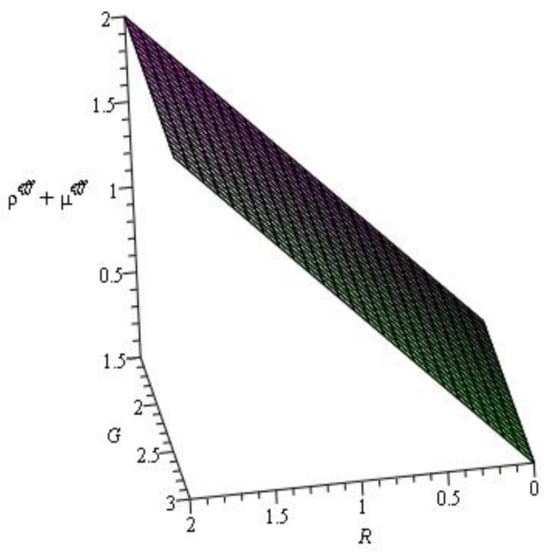
Figure 2.
Evolution of .
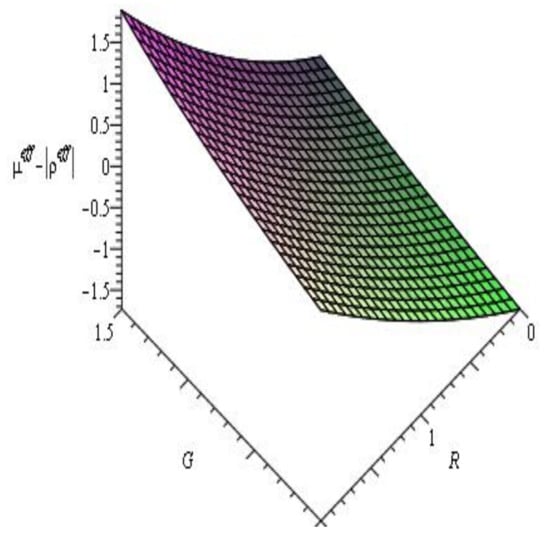
Figure 3.
Evolution of .
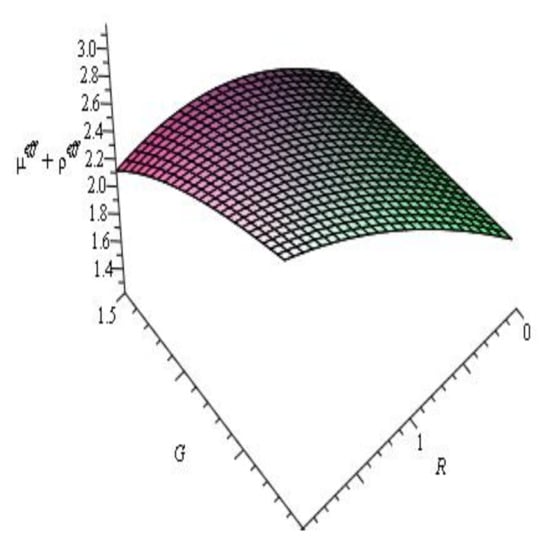
Figure 4.
Evolution of .
- B.
This type of model was also considered by Sebastian Bahamonde et al. []. Here, the effective pressure and the effective energy density for a perfect fluid matter are written by
We are now able to discuss the energy conditions for this setup using Equations (59) and (60). To draw the following figures, we set , and .
Figure 5 shows that the behavior of the energy density is positive for the ranges of parameters and . Figure 6 shows the profile, which also produces a positive value. Therefore, the null energy condition and weak energy condition are satisfied. From Figure 7, we can conclude that the dominant energy condition is violated. Figure 8 shows that the strong energy condition is also verified.
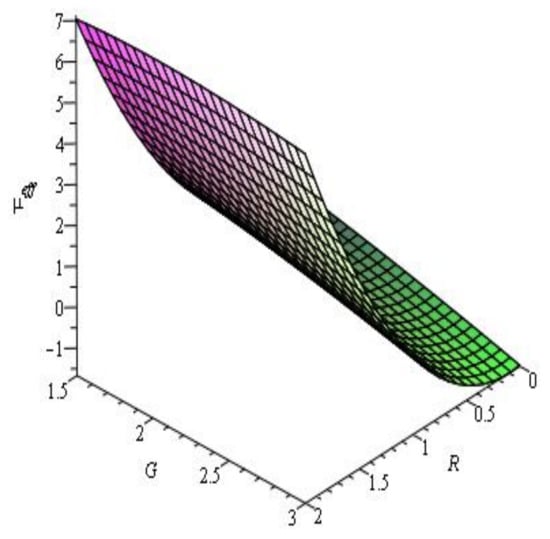
Figure 5.
Evolution of .

Figure 6.
Evolution of .
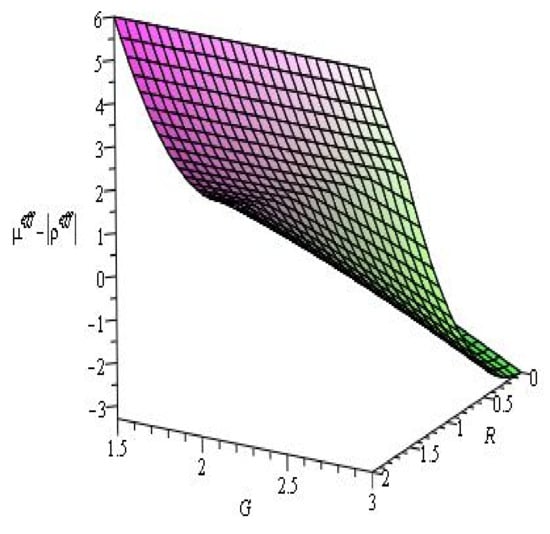
Figure 7.
Evolution of .
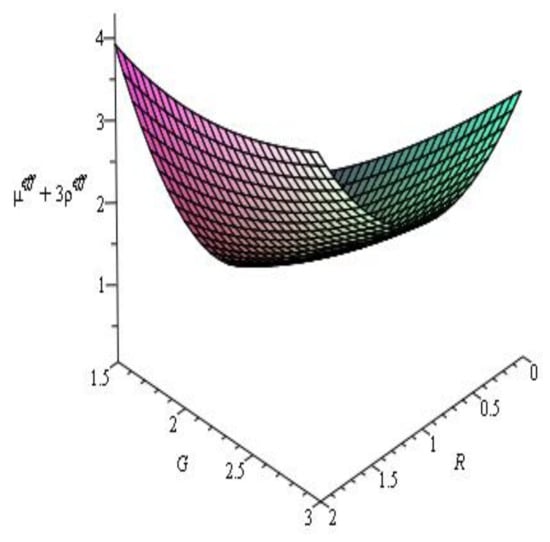
Figure 8.
Evolution of .
Lastly, we choose the well-known flat Friedmann–Robertson–Walker metric
where the universe’s scale factor is denoted by . The cosmological parameters—Hubble (), jerk (j), deceleration (q) and snap (s)—are found in Taylor’s series expansion of a(t). Analysing these parameters helps us to understand the cosmic structure better. The accelerated expansion is investigated in [], on the assumption that unique deceleration parameters emerge throughout the universe. The self-stability of cosmological models in the present universe is examined using these parameters in []. From the Friedmann–Robertson–Walker background, the field equations for gravity are shown by
where and overdot . Further, we infer that
and
Using the Equations (51), (64) and (65), we acquire
Since , then . From these, we can easily calculate
and
We then describe acceleration, velocity, jerk and snap in the context of cosmology using an analogy to classical mechanics. The deceleration, jerk and snap parameters are written by
respectively. Making use of Equations (67)–(69) in (70), we provide , and , and hence we get
Therefore, for a conformally flat weakly Ricci-symmetric space-time fulfilling gravity, the jerk, deceleration and snap parameters are connected by (71).
4. Discussion
Modified gravitational theories are considered as the most exciting and promising approach to examine the current cosmic expansion since they include extra higher-order curvature terms. Here, we study gravity models with the geometric constraint of a conformally flat weakly Ricci-symmetric space-time. The various energy conditions are good candidates to investigate the self-consistency of the modified gravity, and these energy conditions may be found using the well-known Raychaudhuri equation. The null, weak, dominant and strong energy conditions under gravity in a conformally flat weakly Ricci-symmetric space-time have all been examined in this work. Two distinct models have been considered: and . We conclude that in the current scenario, the dominant energy condition exhibits negative behavior for both models, but the null energy condition is always fulfilled. The weak and strong energy requirements are satisfied when and for the two models. The present observational data show the universe’s accelerated expansion, and are thus strongly consistent with both models.
It is possible to investigate modified gravity theories in order to find new theoretical predictions and behaviors that are not present in more conventional general relativity theories. This enables better comprehension of the fundamental laws governing the cosmos. They could provide a different explanation for late-time cosmic acceleration than the generally accepted general relativity theory. This variety of theories is necessary to build a comprehensive knowledge of cosmic acceleration. We examine energy conditions in this setting to assess the validity of the gravity theory. Verifying that the theory fulfills a number of energy conditions is crucial to demonstrating its validity. For late-time cosmology, comprehending the energy conditions and the effects of gravity can have more significant consequences for cosmological models and our comprehension of the universe’s evolution. Using a logarithm and exponential function, this new study will undoubtedly provide some support for research into the cosmos’ late-time acceleration.
Author Contributions
Conceptualization, Y.L., U.C.D. and K.D.; Formal Analysis, Y.L., U.C.D. and K.D.; Investigation, Y.L., U.C.D. and K.D.; Methodology; Y.L., U.C.D. and K.D.; Writing—Original Draft, Y.L., U.C.D. and K.D.; Writing—Review and Editing, Y.L., U.C.D. and K.D. All authors have read and agreed to the published version of the manuscript.
Funding
This research received no external funding.
Data Availability Statement
The original contributions presented in the study are included in the article; further inquiries can be directed to the corresponding author.
Conflicts of Interest
The authors declare no conflicts of interest.
References
- De, K.; De, U.C.; Velimirovic, L. Some curvature properties of perfect fluid spacetimes. Quaest. Math. 2024, 47, 751–764. [Google Scholar] [CrossRef]
- Guler, S.; Demirbag, S.A. A study of generalized quasi-Einstein spacetimes with applications in general relativity. Int. J. Theor. Phys. 2016, 55, 548–562. [Google Scholar] [CrossRef]
- Li, Y.; Alshehri, N.; Ali, A. Riemannian invariants for warped product submanifolds in Qϵm×R and their applications. Open Math. 2024, 22, 20240063. [Google Scholar] [CrossRef]
- Alías, L.; Romero, A.; Sánchez, M. Uniqueness of complete spacelike hypersurfaces of constant mean curvature in generalized Robertson-Walker space-times. Gen. Relativ. Gravit. 1995, 27, 71–84. [Google Scholar] [CrossRef]
- Mantica, C.A.; Molinari, L.G. Twisted Lorentzian manifolds: A characterization with torse-forming time-like unit vectors. Gen. Relativ. Gravit. 2017, 49, 51–58. [Google Scholar] [CrossRef]
- Chen, B.-Y. Totally umbilical submanifolds. Soochow J. Math. 1979, 5, 9–37. [Google Scholar]
- Chen, B.-Y. A simple characterization of generalized Robertson–Walker space-times. Gen. Relativ. Gravit. 2014, 46, 1833. [Google Scholar] [CrossRef]
- Li, Y.; Bhattacharyya, S.; Azami, S.; Hui, S. Li-Yau type estimation of a semilinear parabolic system along geometric flow. J. Inequal. Appl. 2024, 131, 2024. [Google Scholar] [CrossRef]
- Li, Y.; Siddesha, M.S.; Kumara, H.A.; Praveena, M.M. Characterization of Bach and Cotton Tensors on a Class of Lorentzian Manifolds. Mathematics 2024, 12, 3130. [Google Scholar] [CrossRef]
- Li, Y.; Mallick, A.K.; Bhattacharyya, A.; Stankovic, M.S. A Conformal η-Ricci Soliton on a Four-Dimensional Lorentzian Para-Sasakian Manifold. Axioms 2024, 13, 753. [Google Scholar] [CrossRef]
- Mandal, S.; Bhattacharjee, S.; Pacif, S.K.; Sahoo, P.K. Accelerating universe in hybrid and logarithmic teleparallel gravity. Phys. Dark Univ. 2020, 28, 100551. [Google Scholar] [CrossRef]
- Mandal, S.; Sahoo, P.K.; Santos, J.R.L. Energy conditions in f (Q) gravity. Phys. Rev. D 2020, 102, 024057. [Google Scholar] [CrossRef]
- Mantica, C.A.; Molinari, L.G. Generalized Robertson Walker space-times-A survey. Int. J. Geom. Meth. Mod. Phys. 2017, 14, 1730001. [Google Scholar] [CrossRef]
- O’Neill, B. Semi-Riemannian Geometry with Applications to the Relativity; Academic Press: New York, NY, USA; London, UK, 1983. [Google Scholar]
- Chavanis, P.H. Cosmology with a stiff matter era. Phys. Rev. D 2015, 92, 103004. [Google Scholar] [CrossRef]
- Sen, R.N.; Chaki, M.C. On curvature restriction of a certain kind of conformally flat Riemannian spaces of class-one. Proc. Nat. Inst. Sci. India Part A 1967, 33, 100–102. [Google Scholar]
- Chaki, M.C. On pseudo Ricci symmetric manifolds. Bulg. J. Phys. 1988, 15, 526–531. [Google Scholar]
- Tamássy, L.; Binh, T.Q. On weak symmetries of Einstein and Sasakian manifolds. Tensor 1993, 53, 140–148. [Google Scholar]
- Chaki, M.C.; Ray, S. Spacetimes with covariant constant energy momentum tensor. Int. J. Theor. Phys. 1996, 35, 1027–1032. [Google Scholar] [CrossRef]
- Chaki, M.C.; Koley, S. On generalized pseudo Ricci symmetric manifolds. Period. Math. Hungar. 1994, 28, 123–129. [Google Scholar] [CrossRef]
- Mantica, C.A.; Suh, Y.J.; De, U.C. A note on Generalized Robertson Walker space-times. Int. J. Geom. Meth. Mod. Phys. 2016, 13, 1650079. [Google Scholar] [CrossRef]
- Sánchez, M. On the geometry of static space-times. Nonlinear Anal. Theory Methods Appl. 2005, 63, 455–463. [Google Scholar] [CrossRef]
- Hawking, S.W.; Ellis, G.F.R. The Large Scale Structure of Spacetime; Cambridge University Press: Cambridge, UK, 1973. [Google Scholar]
- Patterson, E.M. Some theorems on Ricci-recurrent spaces. J. London Math. Soc. 1952, 27, 287–295. [Google Scholar] [CrossRef]
- Mirzoyan, V.A. Structure theorems for Riemannian Ric-semisymmetric spaces. Russian Math. (Iz. VUZ) 1992, 36, 75–83. [Google Scholar]
- Atazadeh, K.; Darabi, F. Energy conditions in f(R,G) gravity. Gen. Rel. Grav. 2013, 46, 1664. [Google Scholar] [CrossRef]
- Raychaudhuri, A.K.; Banerji, S.; Banerjee, A. General Relativity, Astrophysics, and Cosmology; Springer: New York, NY, USA, 1992. [Google Scholar]
- Duggal, K.L.; Sharma, R. Symmetries of Space-Times and Riemannian Manifolds; Springer: New York, NY, USA, 1999. [Google Scholar]
- Elizalde, E.; Myrzakulov, R.; Obukhov, V.V.; Sáez-Gómez, D. ΛCDM epoch reconstruction from F (R,G)and modified Gauss–Bonnet gravities. Class. Quantum Gravity 2010, 27, 095007. [Google Scholar] [CrossRef]
- De la Cruz-Dombriz, Á.; Sáez-Gómez, D. On the stability of the cosmological solutions in f (R,G) gravity. Class. Quantum Gravity 2012, 29, 245014. [Google Scholar] [CrossRef]
- Laurentis, M.D.; Lopez-Revelles, A.J. Newtonian, Post-Newtonian and Parametrized Post-Newtonian limits of f (R,G) gravity. Int. J. Geom. Methods Mod. Phys. 2014, 11, 1450082. [Google Scholar] [CrossRef]
- Laurentis, M.D.; Paolella, M.; Capozziello, S. Cosmological inflation in f (R,G) gravity. Phys. Rev. D 2015, 91, 083531. [Google Scholar] [CrossRef]
- Bhatti, M.Z.; Yousaf, Z.; Rehman, A.A. Gravastars in f(R,G) gravity. Phys. Dark Universe 2020, 29, 100561. [Google Scholar] [CrossRef]
- Bhatti, M.Z.; Yousaf, Z.; Rehman, A.A. Horizon thermodynamics in f(R,G) gravity. Fortschr. Phys. 2023, 71, 2200113. [Google Scholar] [CrossRef]
- Suh, Y.J.; De, K.; De, U.C. Impact of projective curvature tensor in f (R,G), f (R,T) and f (R,Lm)-gravity. Int. J. Geom. Meth. Mod. Phys. 2024, 21, 2450062. [Google Scholar] [CrossRef]
- Turki, N.B.; De, U.C.; Syied, A.A.; Vilcu, G.E. Investigation of space-times through W2-curvature tensor in f(R,G) gravity. J. Geom. Phys. 2023, 194, 104987. [Google Scholar] [CrossRef]
- Brozos-Vazquez, M.; Garcia-Rio, E.; Vazquez-Lorenzo, R. Some remarks on locally conformally flat static space–times. J. Math. Phys. 2005, 46, 022501. [Google Scholar] [CrossRef]
- Stephani, H.; Kramer, D.; Mac-Callum, M.; Hoenselaers, C.; Herlt, E. Exact Solutions of Einstein’s Field Equations; Cambridge University Press: Cambridge, UK, 2009. [Google Scholar]
- Ehlers, J.; Kundt, W. Gravitation: An Introduction to Current Research; Witten, L., Ed.; Wiley: New York, NY, USA, 1962; p. 49. [Google Scholar]
- Myrzakulov, R.; Sebastiani, L.; Zerbini, S. Topological Static Spherically Symmetric vacuum Solutions in f(R,G) Gravity. Gen. Rel. Grav. 2013, 45, 675–690. [Google Scholar] [CrossRef]
- Bahamonde, S.; Dialektopoulos, K.; Camci, U.U. Exact spherically symmetric solutions in modified Gauss-Bonnet gravity from Noether symmetry approach. Symmetry 2020, 68, 12. [Google Scholar] [CrossRef]
Disclaimer/Publisher’s Note: The statements, opinions and data contained in all publications are solely those of the individual author(s) and contributor(s) and not of MDPI and/or the editor(s). MDPI and/or the editor(s) disclaim responsibility for any injury to people or property resulting from any ideas, methods, instructions or products referred to in the content. |
© 2025 by the authors. Licensee MDPI, Basel, Switzerland. This article is an open access article distributed under the terms and conditions of the Creative Commons Attribution (CC BY) license (https://creativecommons.org/licenses/by/4.0/).